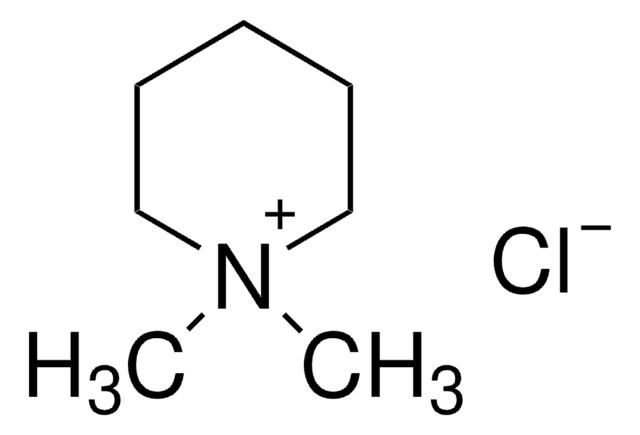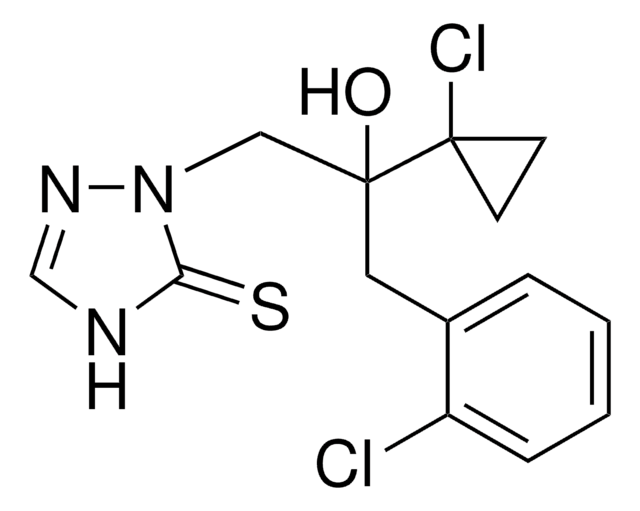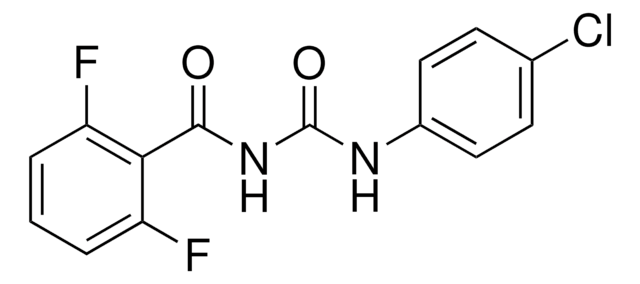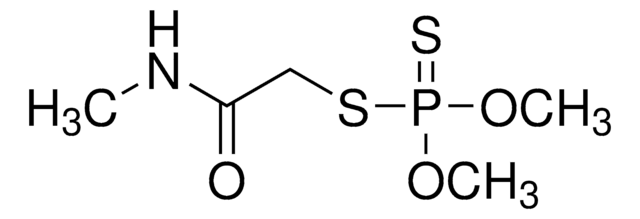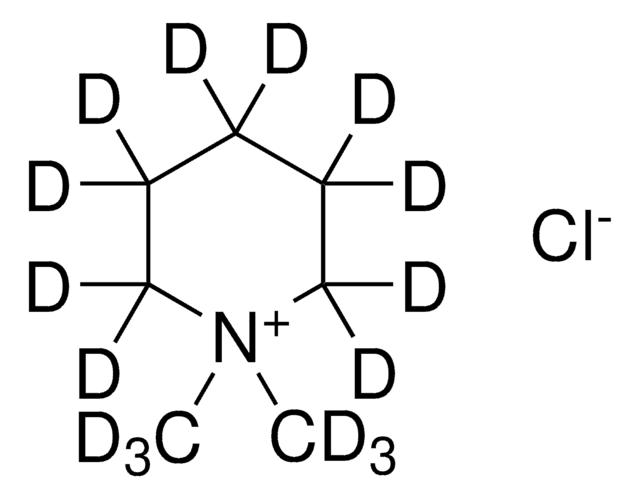おすすめの製品
グレード
certified reference material
TraceCERT®
品質水準
製品種目
TraceCERT®
シェルフライフ
limited shelf life, expiry date on the label
メーカー/製品名
Manufactured by: Sigma-Aldrich Production GmbH, Switzerland
保管温度
2-8°C
SMILES記法
[Cl-].C[N+]1(C)CCCCC1
InChI
1S/C7H16N.ClH/c1-8(2)6-4-3-5-7-8;/h3-7H2,1-2H3;1H/q+1;/p-1
InChI Key
VHOVSQVSAAQANU-UHFFFAOYSA-M
類似した製品をお探しですか? 訪問 製品比較ガイド
詳細
This certified reference material (CRM) is produced and certified in accordance with ISO/IEC 17025 and ISO 17034. This CRM is traceable to primary material from an NMI, e.g. NIST or NMIJ. Certified content by quantitative NMR incl. uncertainty and expiry date are given on the certificate. Download your certificate at: http://www.sigma-aldrich.com
Mepiquat chloride is a synthetic plant growth regulator that is absorbed by the foliage and translocated throughout the plant. It is widely used to manipulate plant structure and helps to combat excessive vegetative growth, which if left uncontrolled can lead to undesirable fruit shed, boll rot, and yield reductions. Mepiquat chloride inhibits gibberellic acid synthesis, thus reducing cell enlargement and cell division rate. Application of mepiquat chloride in cotton results in a more compact plant caused by shortened internode elongation, reduced main stem nodes and decreased leaf expansion and leaf area.
Mepiquat chloride is approved for use in European Union (EU) following Regulation (EC) No 1107/2009 (repealing Directive 91/414/EEC). The maximum residue level (MRL) for Mepiquat (sum of mepiquat and its salts, expressed as mepiquat chloride) is established from 0.02 mg/kg to 4 mg/kg for many plant-based products and 40 mg/kg for linseed, mustard, sunflower, and poppy seeds. For products of animal origin, the MRL is set from 0.05 mg/kg to 0.8 mg/kg as per Reg. (EU) 2021/976.
Mepiquat has to be monitored in the Multiannual Control Programme for Pesticides Residues (MACP), run within the EU and EFTA in/on products of plant origin.
Mepiquat chloride is a synthetic plant growth regulator that is absorbed by the foliage and translocated throughout the plant. It is widely used to manipulate plant structure and helps to combat excessive vegetative growth, which if left uncontrolled can lead to undesirable fruit shed, boll rot, and yield reductions. Mepiquat chloride inhibits gibberellic acid synthesis, thus reducing cell enlargement and cell division rate. Application of mepiquat chloride in cotton results in a more compact plant caused by shortened internode elongation, reduced main stem nodes and decreased leaf expansion and leaf area.
Mepiquat chloride is approved for use in European Union (EU) following Regulation (EC) No 1107/2009 (repealing Directive 91/414/EEC). The maximum residue level (MRL) for Mepiquat (sum of mepiquat and its salts, expressed as mepiquat chloride) is established from 0.02 mg/kg to 4 mg/kg for many plant-based products and 40 mg/kg for linseed, mustard, sunflower, and poppy seeds. For products of animal origin, the MRL is set from 0.05 mg/kg to 0.8 mg/kg as per Reg. (EU) 2021/976.
Mepiquat has to be monitored in the Multiannual Control Programme for Pesticides Residues (MACP), run within the EU and EFTA in/on products of plant origin.
アプリケーション
The certified reference material (CRM) is intended to be used as a calibrant for chromatography and other analytical techniques. Mepiquat chloride CRM can also be used to:
- Evaluate the influence of plant density on cotton response to mepiquat chloride application in order to isolate a specific combination for optimizing plant stature and yield
- Quantify the growth and physiological responses of cotton plants to temperature regimes and mepiquat chloride rates
- Quantify the efficacy of mepiquat chloride on plant height, culm morphological characteristics, lignin accumulation, related enzyme activities, and its relationship with lodging resistance in maize
- Evaluate the roles of gibberellic acid metabolism and signaling in mepiquat chloride-induced inhibition of internode elongation in cotton seedlings
- Evaluate the effects of different mepiquat chloride concentrations on morphological and physiological changes in Eucalyptus clones
おすすめ製品
Find a digital Reference Material for this product available on our online platform ChemisTwin® for NMR. You can use this digital equivalent on ChemisTwin® for your sample identity confirmation and compound quantification (with digital external standard). An NMR spectrum of this substance can be viewed and an online comparison against your sample can be performed with a few mouseclicks. Learn more here and start your free trial.
法的情報
TraceCERT is a registered trademark of Merck KGaA, Darmstadt, Germany
適切な製品が見つかりませんか。
製品選択ツール.をお試しください
シグナルワード
Warning
危険有害性情報
危険有害性の分類
Acute Tox. 4 Oral - Aquatic Chronic 3
保管分類コード
11 - Combustible Solids
WGK
WGK 2
引火点(°F)
Not applicable
引火点(℃)
Not applicable
適用法令
試験研究用途を考慮した関連法令を主に挙げております。化学物質以外については、一部の情報のみ提供しています。 製品を安全かつ合法的に使用することは、使用者の義務です。最新情報により修正される場合があります。WEBの反映には時間を要することがあるため、適宜SDSをご参照ください。
Jan Code
38117-BULK:
38117-50MG:
最新バージョンのいずれかを選択してください:
ライフサイエンス、有機合成、材料科学、クロマトグラフィー、分析など、あらゆる分野の研究に経験のあるメンバーがおります。.
製品に関するお問い合わせはこちら(テクニカルサービス)